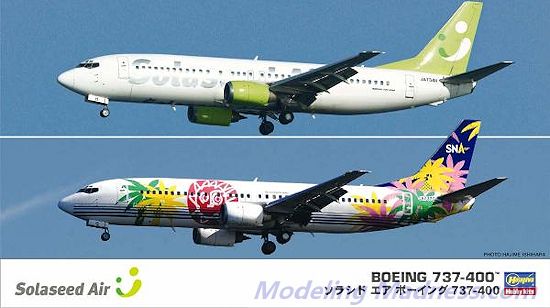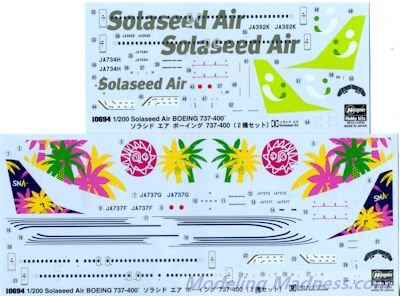
Hasegawa 1/200 Boeing 737-400 'Solaseed Air'
| KIT #: | 10694 |
| PRICE: | 960 yen on sale from Hobby Link Japan (3200 yen SRP) |
| DECALS: | Two options |
| REVIEWER: | Scott Van Aken |
| NOTES: | Two complete kits |

| HISTORY |
First envisioned in 1964, the 737 entered service in 1968. Forty years later it has become the most ordered and produced commercial passenger jet in the world. It is Boeing's last surviving narrow-body airliner, sometimes serving markets previously filled by 707, 727, 757, DC-9 and MD-80/90 airliners. Continuously manufactured by Boeing since 1967 with over 8,000 ordered and over 5,800 delivered as of 2008, there are over 1,250 737s airborne at any given time. On average, a 737 departs or lands somewhere every five seconds.
After the success of the Boeing 737-200 Advanced, Boeing wanted to increase capacity and range, incorporating improvements to upgrade the plane to modern specifications, while also retaining commonality with previous 737 variants. Development began in 1979, and in 1980 preliminary aircraft specifications were released at the Farnborough Airshow. In March 1981 USAir and Southwest Airlines each ordered 10 aircraft, with an option for 20 more.
The new series featured CFM56 turbofan engines, which yielded significant gains in fuel economy and a reduction in noise, but also posed an engineering challenge given the low ground clearance of the 737. Boeing and engine supplier CFMI solved the problem by placing the engine ahead of (rather than below) the wing, and by moving engine accessories to the sides (rather than the bottom) of the engine pod, giving the 737 a distinctive non-circular air intake.
The wing incorporated a number of changes for improved aerodynamics. The wing tip was extended 9 in (23 cm). The leading-edge slots and trailing-edge flaps were adjusted. The flight deck was improved with the optional EFIS (Electronic Flight Instrumentation System), and the passenger cabin incorporated improvements similar to those on the Boeing 757.
The 737-400 was launched in 1985 as a stretched 737-300, primarily for use by charter airlines. Piedmont Airlines was the launch customer with an order for 25 aircraft in 1986.[103] The first 400 entered service in 1988 with Piedmont. The 486th and last delivery of the -400 occurred on February 25, 2000 to CSA Czech Airlines.
The 737-400F was not a model delivered by Boeing but a converted 737-400 to an all cargo aircraft. Alaska Airlines was the first to convert one of its -400s from regular service to an aircraft with the ability to handle 10 pallets. The airline has also converted five more into fixed "combi" aircraft for half passenger and freight. These 737-400 Combi aircraft are now in service.
The 737-300/400/500 aircraft are all considered the '737 Classic' series and have since been replaced by newer variants on the production line.
Solaseed Air (ソラシド エア Sorashido Ea), incorporated as Skynet Asia Airways (スカイネットアジア航空株式会社 Sukainetto Ajia Kōkū Kabushiki-gaisha, SNA) is a low-cost airline headquartered on the property of Miyazaki Airport in Miyazaki, Miyazaki Prefecture, Japan.
It operates services mainly between Miyazaki/Kumamoto/Nagasaki (Kyushu Island) and Tokyo. Beginning September 2007, flights to Kagoshima were scheduled to be introduced. Recently, the airline has announced it will offer discounts for foreign tourists that are up to 65% lower than regular fares. It is the first time a Japanese airline has offered a discount fare aimed only at tourists from abroad. The airline changed its branding to Solaseed Air in July 2011.
| THE KIT |
 Hasegawa
first issued its 'Loveliner' series of 1/200 airliners back in the late 1970s.
At the time, the aircraft had raised panel detail, open cabin windows, and
landing gear that could only be modeled in the 'down' position. This latter
feature required the modeler to expend considerable effort to do a wheels up
display, as often times main gear doors folded into each other when the gear was
down. As cabin window configuration was not always the same, it would require
the modeler to fill in those not needed. However, this was not a problem for a
number of modelers who liked this feature.
Hasegawa
first issued its 'Loveliner' series of 1/200 airliners back in the late 1970s.
At the time, the aircraft had raised panel detail, open cabin windows, and
landing gear that could only be modeled in the 'down' position. This latter
feature required the modeler to expend considerable effort to do a wheels up
display, as often times main gear doors folded into each other when the gear was
down. As cabin window configuration was not always the same, it would require
the modeler to fill in those not needed. However, this was not a problem for a
number of modelers who liked this feature.
This latest in the series has no cabin windows, no cockpit window, optional 'wheels up' landing gear door parts, and fully engraved detailing. Things that are not changed are the inclusion of a display stand and a heft weight for those building the kit with wheels down. In fact, the kit is designed to be put on the stand as there is a large hole in the bottom of the fuselage for the attachment point. For display on the ground, this will need to be filled in. The main gear legs have the doors molded as part of the assembly. I also like that this particular boxing has one piece engine/pylon combinations. No need to be concerned about filling an intake seam. The front fan pieces simply plug in as the exhaust is molded in with the engine.
Tail planes are one piece as are the wings on this version because they are so short. Thanks to the option for wheels up, one can build this in flight, something that many airliner fans can appreciate. Probably the biggest difference from 'standard' airliner kits is that this one has the fuselage split horizontally. Not sure how much that will change things, but it does move the seam to where it will be under the window and cheat-line decals.
 Instructions are standard Hasegawa and use Gunze
paint references. The planes are basically overall white with medium grey wings,
tailplanes and engines. The decals are very nicely printed and allow two
different schemes with Solaseed Air. Each option has two registration numbers
available. You will have to mix the green on the engine cowlings of one of the
two options, but the other shades are white and light gull grey with unpainted
leading edges to the flying surfaces and engine inlets. Of course, cabin and cockpit windows are
included. The decals are the latest new wave type and should react favorably to
setting solutions. The simple livery would make this an ideal first airliner for
someone
Instructions are standard Hasegawa and use Gunze
paint references. The planes are basically overall white with medium grey wings,
tailplanes and engines. The decals are very nicely printed and allow two
different schemes with Solaseed Air. Each option has two registration numbers
available. You will have to mix the green on the engine cowlings of one of the
two options, but the other shades are white and light gull grey with unpainted
leading edges to the flying surfaces and engine inlets. Of course, cabin and cockpit windows are
included. The decals are the latest new wave type and should react favorably to
setting solutions. The simple livery would make this an ideal first airliner for
someone
| CONCLUSIONS |
Obviously these kits sell well. This one is superbly molded and a good buy in the home country. Thanks to the general simplicity of this one and the colorful livery, I can recommend it even to the newest airliner modeler.
| REFERENCES |
http://en.wikipedia.org
http://en.wikipedia.org/wiki/Solaseed_Air
May 2014
My thanks to Hobby Link Japan for the preview kit. At the time of this
preview, the kit is on deep discount at
this link. Get yours
today. If you would like your product reviewed fairly and quickly, please
contact
me or see other details in the
Note to
Contributors.